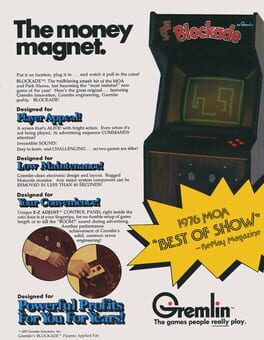

Blockade is a black and white arcade game developed and published by Gremlin in October 1976. Using four directional buttons, each player moves their character around leaving a solid line behind them, turning at 90 degree angles. To win, a player must last longer than the opponent before hitting something, with the first person to hit something losing. The game ends after one player gains six wins. Blockade is the first of what have become known as snake games.
Reviews View More
Where does the versus arcade game go after Atari's Pong or Tank? Both games stuck to the ball-and-paddle paradigm in one way or another. Blockade was the solution: turn Etch-A-Sketch into an entropic competition to fill the screen. Negative space becomes the battleground for a duel of wits and reflexes, as either player tries to snake around each other without colliding. Gremlin's "money magnet" of '76 spawned a whole genre of imitators, leading to the modern snake game as popularized on Nokia phones and the Internet.
It's funny how you can't really play the original snake game, despite its outward simplicity and ease of emulation. We think of the genre today as a single-player experience when it started in the realm of 1-on-1 coin munchers. Arcade-goers still desired the kind of simple competitive pleasures Pong had provided, just with a novel game mechanic. From the moment you and your opponent start moving, with no way to stop, there's a clear, immediate tension. You're all walled in, and you've got nowhere to go but closer to your foe.
Pong, Tank, and Spacewar! before them worked because they provided the illusion of an open space you could play in, even if you either stuck to one plane of movement or had limited room for exchanging fire. I think the genius of Blockade comes from dispelling that notion entirely. You're never in any doubt about your opportunities to corner and trick the other player. And you've always got the harsh green borders of the screen to keep you focused, mentally hemmed in by the game. Clash is inevitable in this slowly filling digital world, promising not the freedom of an open space but a ruthless drive to destruction.
Today, it all seems a bit quaint. We're many decades separated from Blockade—the progenitor of not just snake games all about managing a depleting space, but the confinement of the fighting game genre too. As fast as this must have seemed in '76, it's laborious and simply dull to play today. Indeed, Gremlin engineer Lane Hauck's creation "wasn't a good game from the standpoint of making money...The industry loved Blockade but the public yawned.". Creators like him recognized the sea change this game proved was feasible, though. It wouldn't be long before Disney's TRON demonstrated how exciting this concept could be. Moreover, Blockade's success with operators showed that Tank was no fluke, that plenty of multiplayer dueling concepts beyond the ball and paddle were not just viable, but desirable.
All in all, I can't really hold much against a game that did well enough to get clones with names like Bigfoot Bonkers. I'd have never grown up chomping down every little dot on my flip-phone LCD screen were it not for this. (Hell, where would Head-On or Pac-Man be if Blockade hadn't paved the way?!) Of their pre-SEGA achievements, Gremlin's original screen filler has earned its place in arcade game history.
It's funny how you can't really play the original snake game, despite its outward simplicity and ease of emulation. We think of the genre today as a single-player experience when it started in the realm of 1-on-1 coin munchers. Arcade-goers still desired the kind of simple competitive pleasures Pong had provided, just with a novel game mechanic. From the moment you and your opponent start moving, with no way to stop, there's a clear, immediate tension. You're all walled in, and you've got nowhere to go but closer to your foe.
Pong, Tank, and Spacewar! before them worked because they provided the illusion of an open space you could play in, even if you either stuck to one plane of movement or had limited room for exchanging fire. I think the genius of Blockade comes from dispelling that notion entirely. You're never in any doubt about your opportunities to corner and trick the other player. And you've always got the harsh green borders of the screen to keep you focused, mentally hemmed in by the game. Clash is inevitable in this slowly filling digital world, promising not the freedom of an open space but a ruthless drive to destruction.
Today, it all seems a bit quaint. We're many decades separated from Blockade—the progenitor of not just snake games all about managing a depleting space, but the confinement of the fighting game genre too. As fast as this must have seemed in '76, it's laborious and simply dull to play today. Indeed, Gremlin engineer Lane Hauck's creation "wasn't a good game from the standpoint of making money...The industry loved Blockade but the public yawned.". Creators like him recognized the sea change this game proved was feasible, though. It wouldn't be long before Disney's TRON demonstrated how exciting this concept could be. Moreover, Blockade's success with operators showed that Tank was no fluke, that plenty of multiplayer dueling concepts beyond the ball and paddle were not just viable, but desirable.
All in all, I can't really hold much against a game that did well enough to get clones with names like Bigfoot Bonkers. I'd have never grown up chomping down every little dot on my flip-phone LCD screen were it not for this. (Hell, where would Head-On or Pac-Man be if Blockade hadn't paved the way?!) Of their pre-SEGA achievements, Gremlin's original screen filler has earned its place in arcade game history.
